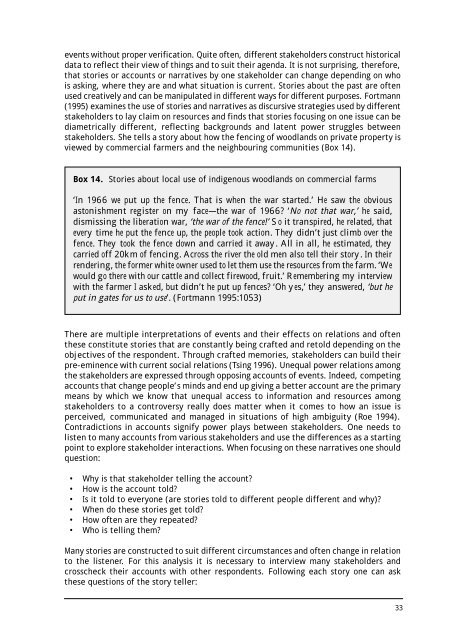Where the power lies: multiple stakeholder politics over natural ...
Where the power lies: multiple stakeholder politics over natural ...
Where the power lies: multiple stakeholder politics over natural ...
You also want an ePaper? Increase the reach of your titles
YUMPU automatically turns print PDFs into web optimized ePapers that Google loves.
events without proper verification. Quite often, different <strong>stakeholder</strong>s construct historical<br />
data to reflect <strong>the</strong>ir view of things and to suit <strong>the</strong>ir agenda. It is not surprising, <strong>the</strong>refore,<br />
that stories or accounts or narratives by one <strong>stakeholder</strong> can change depending on who<br />
is asking, where <strong>the</strong>y are and what situation is current. Stories about <strong>the</strong> past are often<br />
used creatively and can be manipulated in different ways for different purposes. Fortmann<br />
(1995) examines <strong>the</strong> use of stories and narratives as discursive strategies used by different<br />
<strong>stakeholder</strong>s to lay claim on resources and finds that stories focusing on one issue can be<br />
diametrically different, reflecting backgrounds and latent <strong>power</strong> struggles between<br />
<strong>stakeholder</strong>s. She tells a story about how <strong>the</strong> fencing of woodlands on private property is<br />
viewed by commercial farmers and <strong>the</strong> neighbouring communities (Box 14).<br />
Box 14. Stories about local use of indigenous woodlands on commercial farms<br />
‘In 1966 we put up <strong>the</strong> fence. That is when <strong>the</strong> war started.’ He saw <strong>the</strong> obvious<br />
astonishment register on my face—<strong>the</strong> war of 1966? ‘No not that war,’ he said,<br />
dismissing <strong>the</strong> liberation war, ‘<strong>the</strong> war of <strong>the</strong> fence!’ So it transpired, he related, that<br />
every time he put <strong>the</strong> fence up, <strong>the</strong> people took action. They didn’t just climb <strong>over</strong> <strong>the</strong><br />
fence. They took <strong>the</strong> fence down and carried it away. All in all, he estimated, <strong>the</strong>y<br />
carried off 20km of fencing. Across <strong>the</strong> river <strong>the</strong> old men also tell <strong>the</strong>ir story. In <strong>the</strong>ir<br />
rendering, <strong>the</strong> former white owner used to let <strong>the</strong>m use <strong>the</strong> resources from <strong>the</strong> farm. ‘We<br />
would go <strong>the</strong>re with our cattle and collect firewood, fruit.’ Remembering my interview<br />
with <strong>the</strong> farmer I asked, but didn’t he put up fences? ‘Oh yes,’ <strong>the</strong>y answered, ‘but he<br />
put in gates for us to use’. (Fortmann 1995:1053)<br />
There are <strong>multiple</strong> interpretations of events and <strong>the</strong>ir effects on relations and often<br />
<strong>the</strong>se constitute stories that are constantly being crafted and retold depending on <strong>the</strong><br />
objectives of <strong>the</strong> respondent. Through crafted memories, <strong>stakeholder</strong>s can build <strong>the</strong>ir<br />
pre-eminence with current social relations (Tsing 1996). Unequal <strong>power</strong> relations among<br />
<strong>the</strong> <strong>stakeholder</strong>s are expressed through opposing accounts of events. Indeed, competing<br />
accounts that change people’s minds and end up giving a better account are <strong>the</strong> primary<br />
means by which we know that unequal access to information and resources among<br />
<strong>stakeholder</strong>s to a contr<strong>over</strong>sy really does matter when it comes to how an issue is<br />
perceived, communicated and managed in situations of high ambiguity (Roe 1994).<br />
Contradictions in accounts signify <strong>power</strong> plays between <strong>stakeholder</strong>s. One needs to<br />
listen to many accounts from various <strong>stakeholder</strong>s and use <strong>the</strong> differences as a starting<br />
point to explore <strong>stakeholder</strong> interactions. When focusing on <strong>the</strong>se narratives one should<br />
question:<br />
Why is that <strong>stakeholder</strong> telling <strong>the</strong> account?<br />
How is <strong>the</strong> account told?<br />
Is it told to everyone (are stories told to different people different and why)?<br />
When do <strong>the</strong>se stories get told?<br />
How often are <strong>the</strong>y repeated?<br />
Who is telling <strong>the</strong>m?<br />
Many stories are constructed to suit different circumstances and often change in relation<br />
to <strong>the</strong> listener. For this analysis it is necessary to interview many <strong>stakeholder</strong>s and<br />
crosscheck <strong>the</strong>ir accounts with o<strong>the</strong>r respondents. Following each story one can ask<br />
<strong>the</strong>se questions of <strong>the</strong> story teller:<br />
33

















